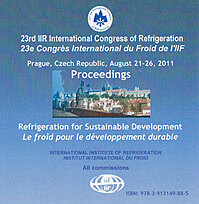
Résumé
Carbon dioxide is known to perform well as a refrigerant in applications like heat pump water heaters, mobile air conditioning and commercial refrigeration. The coefficient of performance in a transcritical CO2 cycle can be improved by minimizing the thermodynamic throttling losses with an expansion-compression unit. In this project, an expansion-compression-unit (ECU), based on a free piston design, was integrated into a CO2 refrigeration system to verify the practicability and the performance of the system in the field. The expansion-compression-unit was designed and dimensioned, machined and assembled. The integration of the machine into the refrigeration system required evaluation, design and assembling of additional components such as an intercooler, piping, valves and control components. A regulation scheme was developed and has successfully been implemented into the standard refrigeration controls. Technical challenges have been met in terms of lubrication, control strategy, dynamics and mechanics after commissioning the refrigeration plant and the ECU.
Documents disponibles
Format PDF
Pages : 8 p.
Disponible
Prix public
20 €
Prix membre*
Gratuit
* meilleur tarif applicable selon le type d'adhésion (voir le détail des avantages des adhésions individuelles et collectives)
Détails
- Titre original : Integration of an expansion-compression unit for CO2 into a refrigeration system in the field.
- Identifiant de la fiche : 30001109
- Langues : Anglais
- Source : Proceedings of the 23rd IIR International Congress of Refrigeration: Prague, Czech Republic, August 21-26, 2011. Overarching theme: Refrigeration for Sustainable Development.
- Date d'édition : 21/08/2011
Liens
Voir d'autres communications du même compte rendu (569)
Voir le compte rendu de la conférence
-
Anti-synchronizing control for supermarket refr...
- Auteurs : LARSEN L. F. S., THYBO C., WISNIEWSKI R., et al.
- Date : 21/08/2007
- Langues : Anglais
- Source : ICR 2007. Refrigeration Creates the Future. Proceedings of the 22nd IIR International Congress of Refrigeration.
- Formats : PDF
Voir la fiche
-
Energy efficient control strategies in supermar...
- Auteurs : SCHULTE A., LARSEN L., FÖRSTERLING S., HEERUP C., TEGETHOFF W., ZÜHLSDORF B., KOEHLER J.
- Date : 11/06/2024
- Langues : Anglais
- Source : 8th IIR International Conference on Sustainability and the Cold Chain. Proceedings: June 9-11 2024
- Formats : PDF
Voir la fiche
-
Supermarket refrigeration systems: towards mini...
- Auteurs : WINANDY E.
- Date : 06/04/2009
- Langues : Anglais
- Source : RCR 2009. 1st IIR Workshop on Refrigerant Charge Reduction in Refrigerating Systems.
- Formats : PDF
Voir la fiche
-
Secondary refrigerant system options for superm...
- Auteurs : HESSE U.
- Date : 23/10/1995
- Langues : Anglais
- Source : Stratospheric Ozone Protection for the 90's. 1995 International CFC and Halon Alternatives Conference & Exhibition. Conference proceedings.
Voir la fiche
-
Energy consumption evaluation of indirect syste...
- Auteurs : SAWALHA S., PALM B.
- Date : 17/08/2003
- Langues : Anglais
- Source : 21st IIR International Congress of Refrigeration: Serving the Needs of Mankind.
- Formats : PDF
Voir la fiche
